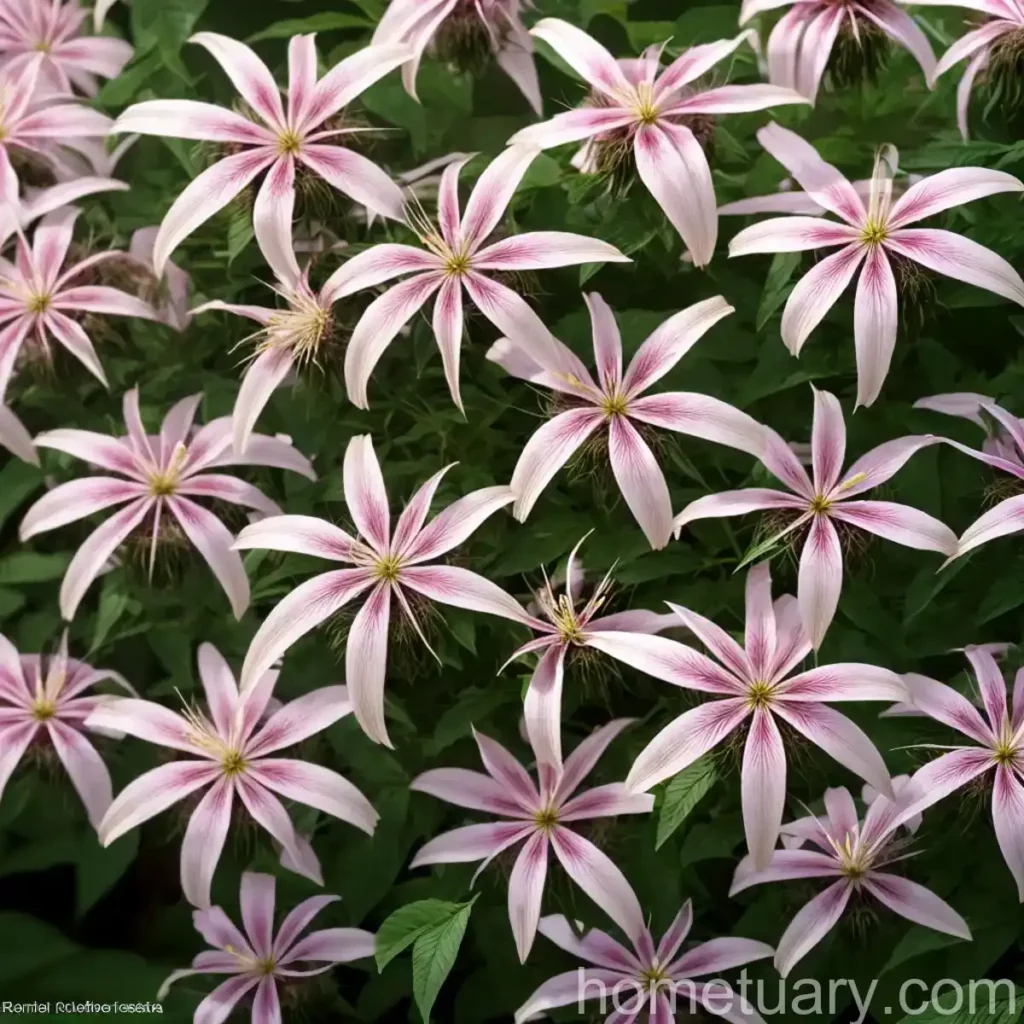The Marvelous Spider Flower: Cleome ‘Inncleosr’ SENORITA ROSALITA
Plants have always been a fascination for humanity, offering an incredible variety of shapes, colors, and scents. In a world where the ordinary is easily forgotten, the spider flower, scientifically known as Cleome ‘Inncleosr’ SENORITA ROSALITA, is anything but ordinary. Its unique appearance and low-maintenance qualities make it a popular choice for gardens, landscapes, and containers. In this comprehensive guide, we will delve into the intricate details of this beautiful plant, exploring its characteristics, growth habits, care requirements, and much more.
What is the Spider Flower (Cleome ‘Inncleosr’ SENORITA ROSALITA)?
The spider flower, or Cleome ‘Inncleosr’ SENORITA ROSALITA, is an enchanting perennial plant renowned for its vibrant and delicate flowers. Belonging to the Cleomaceae family, this plant is native to South America and has gained widespread popularity for its stunning ornamental value. With its long blooming period and attractive foliage, the SENORITA ROSALITA variety of the spider flower has captured the hearts of many garden enthusiasts.
Key Takeaways – Spider Flower (Cleome ‘Inncleosr’ SENORITA ROSALITA)
Before diving into the intricacies of cultivating and caring for the spider flower, it’s essential to understand the fundamental aspects and key takeaways associated with this captivating plant. Here are some of the critical points to keep in mind:
- Scientific Name: Cleome ‘Inncleosr’ SENORITA ROSALITA
- Family: Cleomaceae
- Common Name: Spider Flower
- Plant Type: Herbaceous Perennial
- Foliage: Fresh green, compound leaves
- Flower Color: Deep pink to lavender
- Flowering Season: Spring to fall
- Growth Habit: Upright, bushy
- Watering Needs: Moderate
- Sunlight Requirements: Full sun to partial shade
- Soil Type: Well-draining, fertile soil
- Container Size: Suitable for medium to large containers
- Maintenance: Low to moderate
- Special Features: Attracts pollinators, long blooming period
Understanding these key points lays a strong foundation for comprehending the specific care requirements, growth patterns, and potential uses of the spider flower.
Culture
The culture of the spider flower encompasses various elements, including its natural habitat, preferred growing conditions, and overall adaptability. Understanding the cultural preferences of Cleome ‘Inncleosr’ SENORITA ROSALITA is crucial for creating an environment that fosters its healthy growth and abundant blooming.
Uses
The spider flower, with its striking appearance and versatile nature, finds multiple uses in both outdoor and indoor settings. Its primary uses include:
- Ornamental Plant: The spider flower is predominantly cultivated for its ornamental value, adding a touch of elegance and charm to gardens, landscapes, and containers.
- Cut Flower: The long-lasting blooms of Cleome ‘Inncleosr’ SENORITA ROSALITA make it an excellent choice for cut flower arrangements, bringing its unique beauty indoors.
Water
Maintaining an optimal watering routine is crucial for the health and vitality of the spider flower. While this plant is relatively resilient, providing adequate moisture is essential for promoting robust growth and prolific blooming. Here are some key points to consider regarding the water requirements of Cleome ‘Inncleosr’ SENORITA ROSALITA:
- Watering Schedule: Consistent watering is essential, especially during the active growing season. Aim to water the plant when the top inch of the soil feels dry to the touch.
- Avoid Waterlogging: Ensure that the soil has proper drainage to prevent waterlogging, which can lead to root rot and other water-related issues.
Sunlight
As with many flowering plants, sunlight plays a critical role in the growth and blooming of the spider flower. Understanding its sunlight requirements is essential for providing an environment where Cleome ‘Inncleosr’ SENORITA ROSALITA can thrive. Here’s what you need to know about its sunlight needs:
- Sun Exposure: The spider flower thrives in full sun to partial shade. In regions with intense heat, providing some afternoon shade can help prevent sunscald and heat stress.
Fertilizer
Proper nourishment is key to unlocking the full potential of the spider flower, bolstering its growth, and enhancing its floral display. When it comes to fertilizing Cleome ‘Inncleosr’ SENORITA ROSALITA, a balanced approach is vital to prevent nutrient deficiencies and promote overall vigor. Consider the following points regarding fertilizer application:
- Fertilizer Type: Use a balanced, all-purpose fertilizer with equal NPK (Nitrogen, Phosphorus, Potassium) ratios to support healthy growth and abundant flowering.
- Frequency: Apply fertilizer every four to six weeks during the growing season, reducing frequency during the winter months when the plant is less active.
Soil
The soil forms the foundation for the growth and development of the spider flower. Understanding the soil preferences and requirements of Cleome ‘Inncleosr’ SENORITA ROSALITA is crucial for establishing an environment that fosters optimal growth. Here are the primary considerations for the soil needs of this captivating plant:
- Well-Draining Soil: The spider flower thrives in well-draining, fertile soil that allows excess moisture to escape, preventing waterlogged conditions.
- pH Level: Maintain a slightly acidic to neutral soil pH (6.0-7.0) to ensure proper nutrient uptake by the plant roots.
- Soil Amendment: Incorporate organic matter such as compost or well-rotted manure into the soil to improve its structure and fertility.
Pruning
Pruning is an essential aspect of spider flower maintenance, promoting tidiness, shaping the plant, and encouraging continuous blooming. Understanding the key principles of pruning Cleome ‘Inncleosr’ SENORITA ROSALITA enhances its overall appearance and health. Here’s what you need to know about pruning this beautiful plant:
- Deadheading: Regularly remove spent flowers to encourage the production of new blooms and prevent the plant from directing energy into seed production.
- Trimming: As the plant grows, occasional trimming of leggy or overgrown stems can help maintain a compact and attractive form.
Propagation
For enthusiasts looking to expand their spider flower collection or share the beauty of Cleome ‘Inncleosr’ SENORITA ROSALITA with others, propagation is an exciting avenue to explore. Understanding the different propagation techniques and methods is essential for successfully multiplying these enchanting plants. Consider the following propagation options for the spider flower:
- Seed Propagation: Spider flowers can be easily propagated from seeds, which should be sown indoors several weeks before the last frost date or directly in the garden once the soil has warmed up.
- Division: Established plants can be divided in early spring, with each division having a healthy root system and several shoots.
Container Popularity
The spider flower has gained substantial popularity as a container plant, adding a dash of elegance and color to balconies, patios, and outdoor spaces. The compact growth habit and striking flowers of Cleome ‘Inncleosr’ SENORITA ROSALITA make it an ideal choice for various container sizes, including medium to large planters.
Container Common Diseases
While the spider flower is generally resilient, it may be susceptible to certain diseases, particularly when grown in containers. The following are common diseases that can affect Cleome ‘Inncleosr’ SENORITA ROSALITA when cultivated in containers:
- Powdery Mildew: This fungal disease can occur in humid conditions, causing a white powdery substance to form on the leaves and stems.
- Gray Mold: Gray mold, caused by the Botrytis cinerea fungus, can lead to rotting of flowers and foliage, particularly in moist and poorly ventilated environments.
- Root Rot: Overwatering or poorly draining soil in containers can lead to root rot, resulting in wilting, yellowing, or browning of the plant.
Disease Diagnosis
Diagnosing and addressing potential diseases in the spider flower is crucial for preventing widespread damage and maintaining its overall health. Early detection and prompt action are key in managing and mitigating the impact of diseases. Here’s how to diagnose potential diseases in Cleome ‘Inncleosr’ SENORITA ROSALITA:
- Observation: Regularly inspect the plant for any signs of discoloration, distortion, or unusual growth patterns.
- Symptom Analysis: Identify specific symptoms such as powdery residues, wilting, or decaying plant parts to narrow down potential diseases.
- Consultation: If uncertain about the diagnosis, seek guidance from plant experts or gardening professionals to confirm the issue and determine an appropriate course of action.
Common Pests
Pests can pose a threat to the health and vitality of the spider flower, potentially causing damage to its foliage, flowers, or overall growth. Understanding the common pests that may target Cleome ‘Inncleosr’ SENORITA ROSALITA is essential for implementing preventive measures and addressing infestations effectively. Here are some of the common pests that may affect the spider flower:
- Aphids: These small, soft-bodied insects can cluster on new growth, causing distortion and yellowing of leaves.
- Spider Mites: These tiny arachnids can infest the undersides of leaves, causing stippling, discoloration, and webbing.
- Whiteflies: Whiteflies can congregate on the undersides of leaves, sapping plant sap and causing yellowing or wilting.
Botanist’s Tips
As with any plant, mastering the key elements of successful cultivation and care is essential for nurturing healthy and thriving specimens of the spider flower. Here are some valuable tips and insights from botanists and experienced gardeners to help you make the most of growing Cleome ‘Inncleosr’ SENORITA ROSALITA:
- Provide Adequate Space: When planting spider flowers, ensure that they have enough space to grow to their full potential, as overcrowding can lead to increased disease susceptibility and reduced airflow.
- Monitor Moisture Levels: While providing consistent moisture is essential, avoid overwatering the spider flower, as excessively wet conditions can promote fungal diseases and root rot.
- Encourage Pollinators: The vibrant blooms of the spider flower attract pollinators such as butterflies and bees, making it a valuable addition to pollinator-friendly gardens.
- Support Tall Stems: As the spider flower grows, consider staking or providing support to tall stems to prevent them from bending or breaking under the weight of the flowers.
Fun Facts
Exploring the intriguing and captivating aspects of the spider flower adds a layer of fascination to its already enchanting presence. Here are some fun and captivating facts about Cleome ‘Inncleosr’ SENORITA ROSALITA:
- Attracts Hummingbirds: The tubular flowers of the spider flower are known to attract hummingbirds, adding to the lively ambiance of gardens and landscapes.
- No Spider Relation: Despite its common name, the spider flower is not related to spiders, but rather derives its name from the appearance of its long stamens, which resemble a spider’s legs.
- Drought Tolerance: While requiring consistent moisture, the spider flower exhibits a degree of drought tolerance once established, making it suitable for regions with periodic water scarcity.
Links to External Resources
Plant Name: Spider Flower (Cleome ‘Inncleosr’ SENORITA ROSALITA)
For further exploration and in-depth information on the spider flower, consider exploring the following external resources:
- 1. Spider Plant Varieties
- 2. Cleome ‘Inncleosr’ SENORITA ROSALITA
- 3. Spider Flower Care Tips
- 4. Growing Spider Flowers
- 5. Cleome SENORITA ROSALITA
- 6. Spider Flower Characteristics
- 7. Spider Plant Varieties for Landscaping
- 8. Cleome ‘Inncleosr’ Plant
- 9. Spider Plant Maintenance
- 10. SENORITA ROSALITA Spider Flower
- 11. Cleome ‘Inncleosr’ SENORITA ROSALITA Plant Care
- 12. Spider Flower in Gardens
- 13. Spider Plant Cultivation
- 14. Cleome SENORITA ROSALITA Benefits
- 15. Spider Flower Planting Guide
- 16. Cleome ‘Inncleosr’ SENORITA ROSALITA Features
- 17. Spider Plant Uses
- 18. Spider Flower Landscape Design
- 19. Cleome ‘Inncleosr’ SENORITA ROSALITA Characteristics
- 20. Spider Plant for Beginners
- 21. Spider Flower Propagation Techniques
- 22. Cleome SENORITA ROSALITA Diseases
- 23. Spider Plant for Indoor Gardening
- 24. Cleome ‘Inncleosr’ SENORITA ROSALITA Flowers
- 25. Spider Flower Pruning Tips
- 26. Cleome SENORITA ROSALITA Soil Requirements
- 27. Spider Plant Watering Needs
- 28. Cleome ‘Inncleosr’ SENORITA ROSALITA Growth Habits
- 29. Spider Flower Planting Season
- 30. Cleome SENORITA ROSALITA Container Gardening
- 31. Spider Plant Pest Control Methods
- 32. Cleome ‘Inncleosr’ SENORITA ROSALITA Bloom Time
- 33. Spider Flower Companion Plants
- 34. Cleome SENORITA ROSALITA Pruning Techniques
- 35. Spider Plant Outdoor Care
- 36. Cleome ‘Inncleosr’ SENORITA ROSALITA Sunlight Requirements
- 37. Spider Flower in Full Sun
- 38. Cleome SENORITA ROSALITA Fertilization Tips
- 39. Spider Plant Winter Care
- 40. Cleome ‘Inncleosr’ SENORITA ROSALITA Fragrance
- 41. Spider Flower Landscaping Ideas
- 42. Cleome SENORITA ROSALITA Plant Family
- 43. Spider Plant Common Problems
- [44. Cleome ‘Inncleosr’ SENORITA ROSALITA Watering Schedule](https://mlo-botanicals-and-design.com/spider-fl















